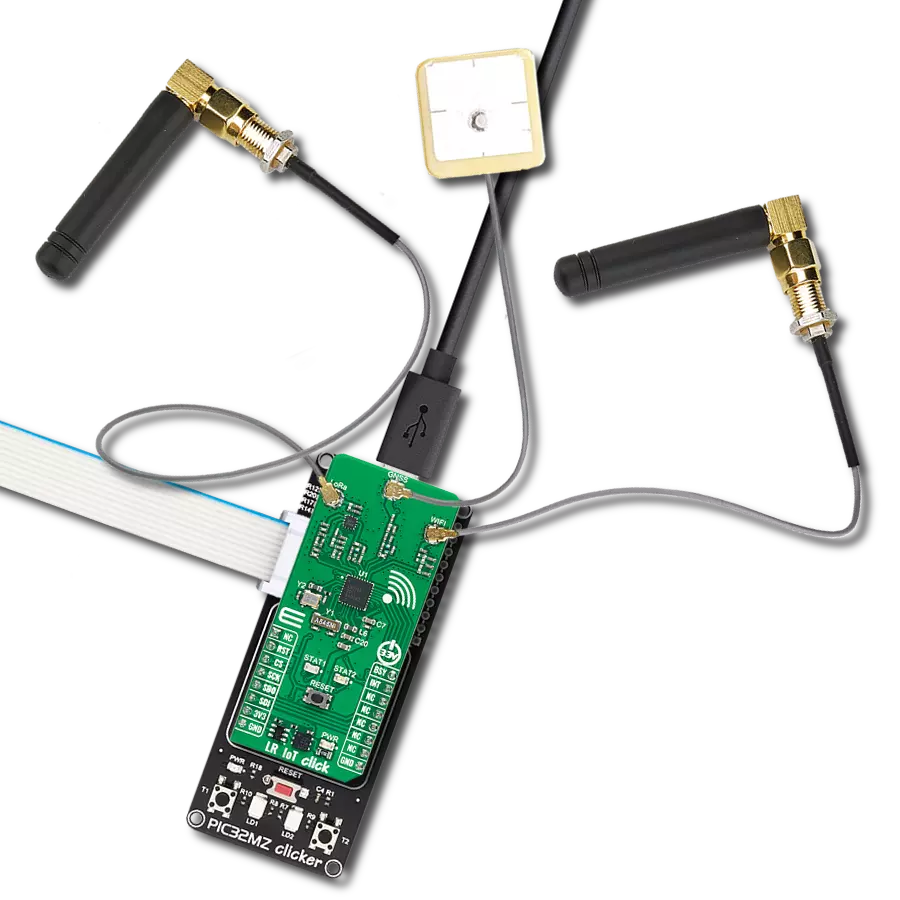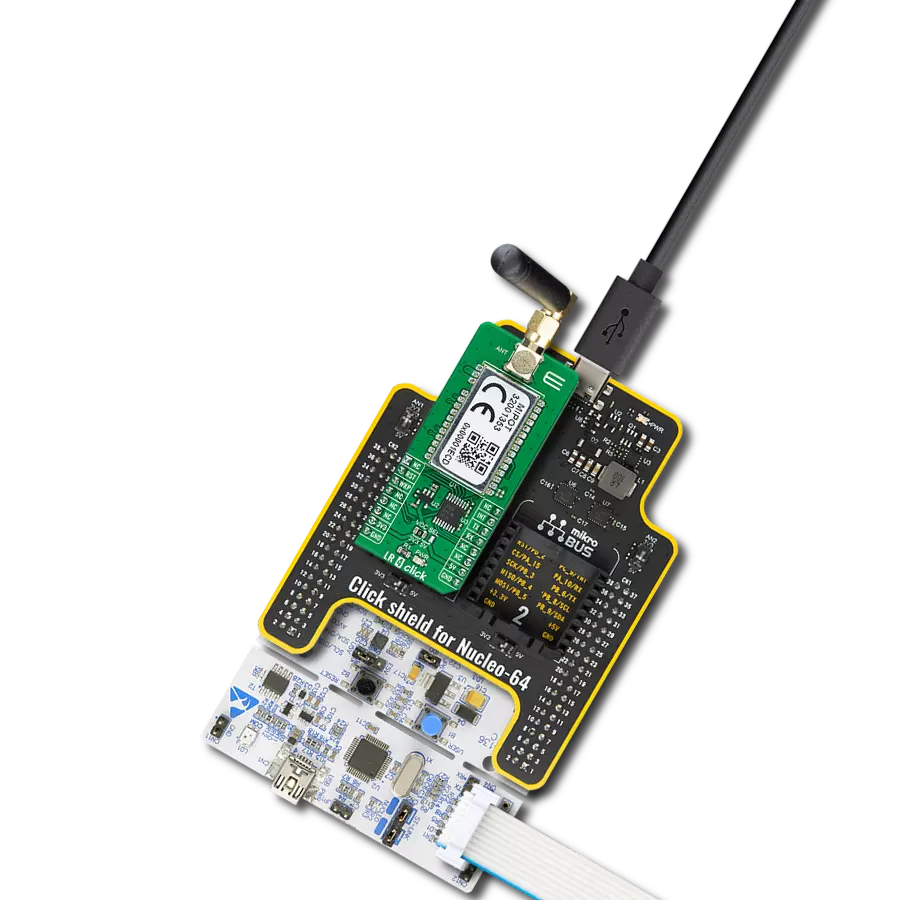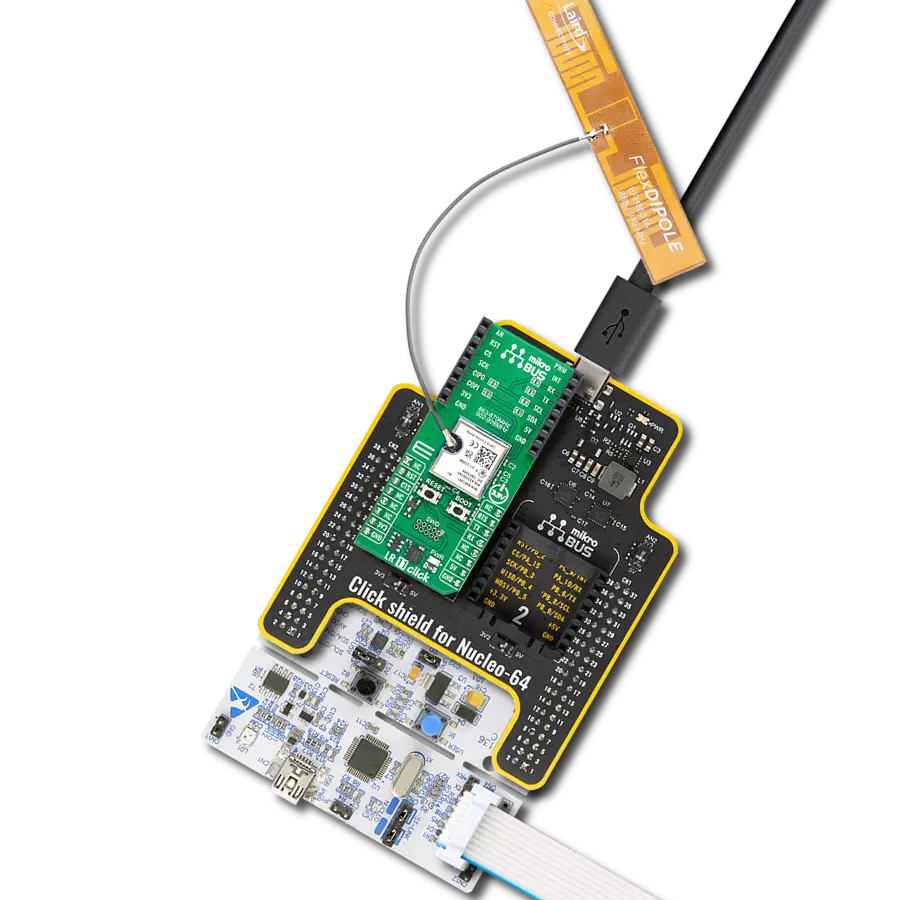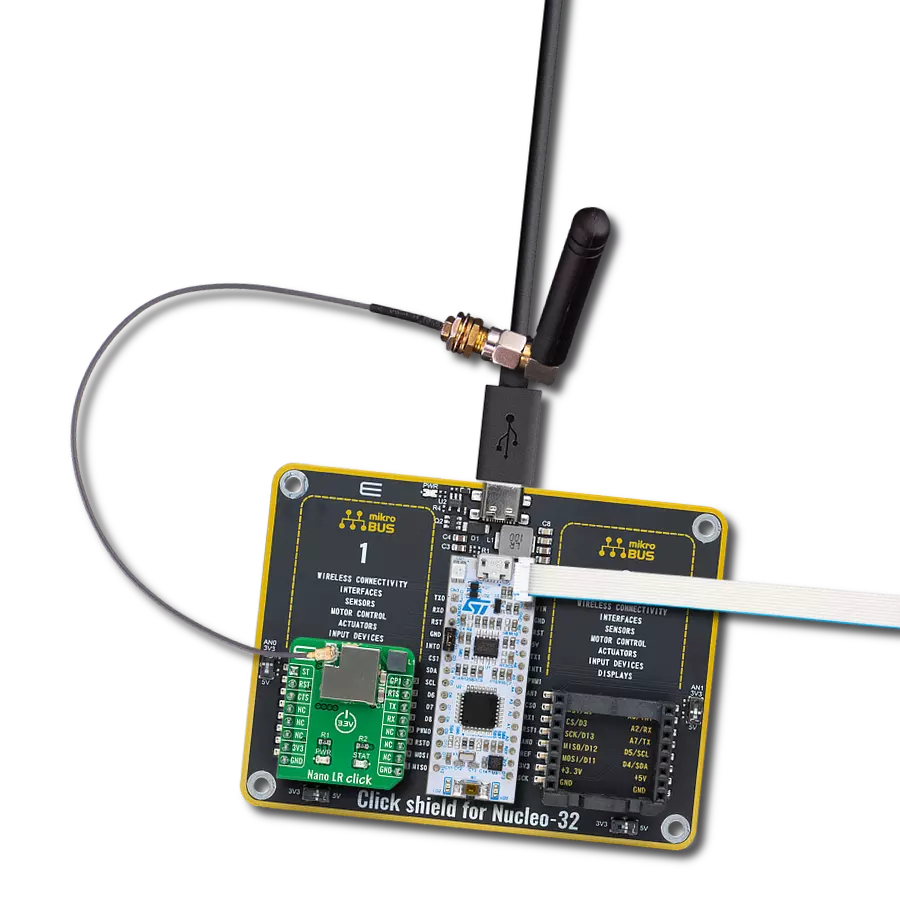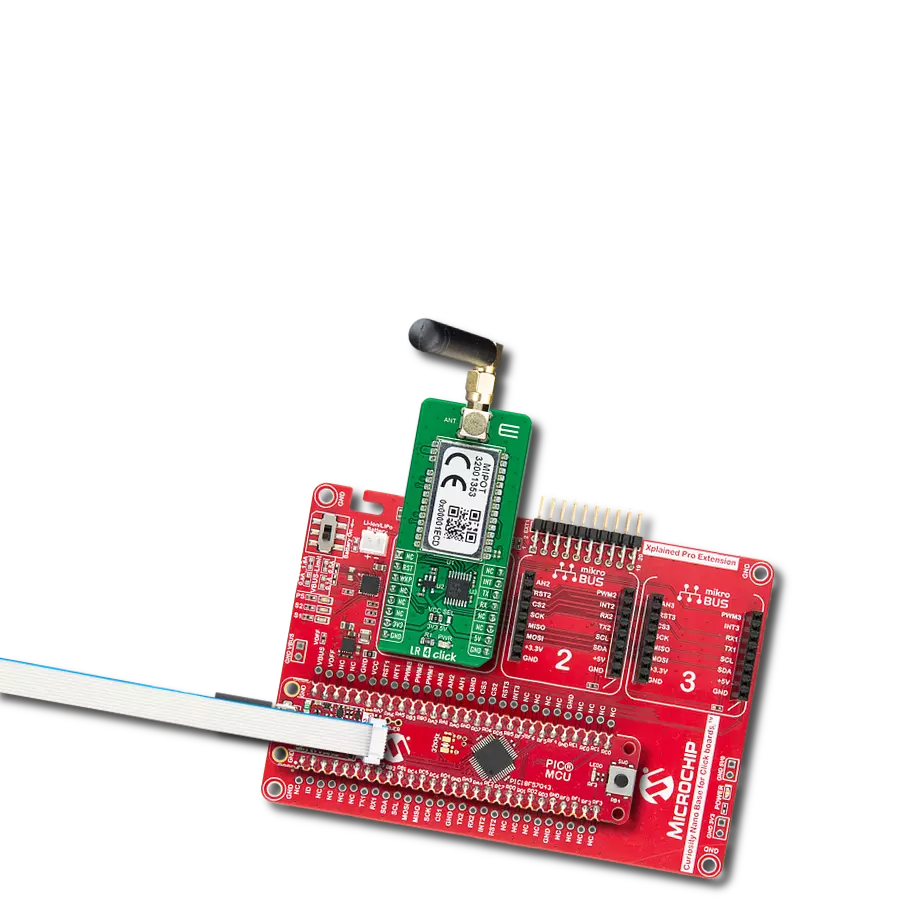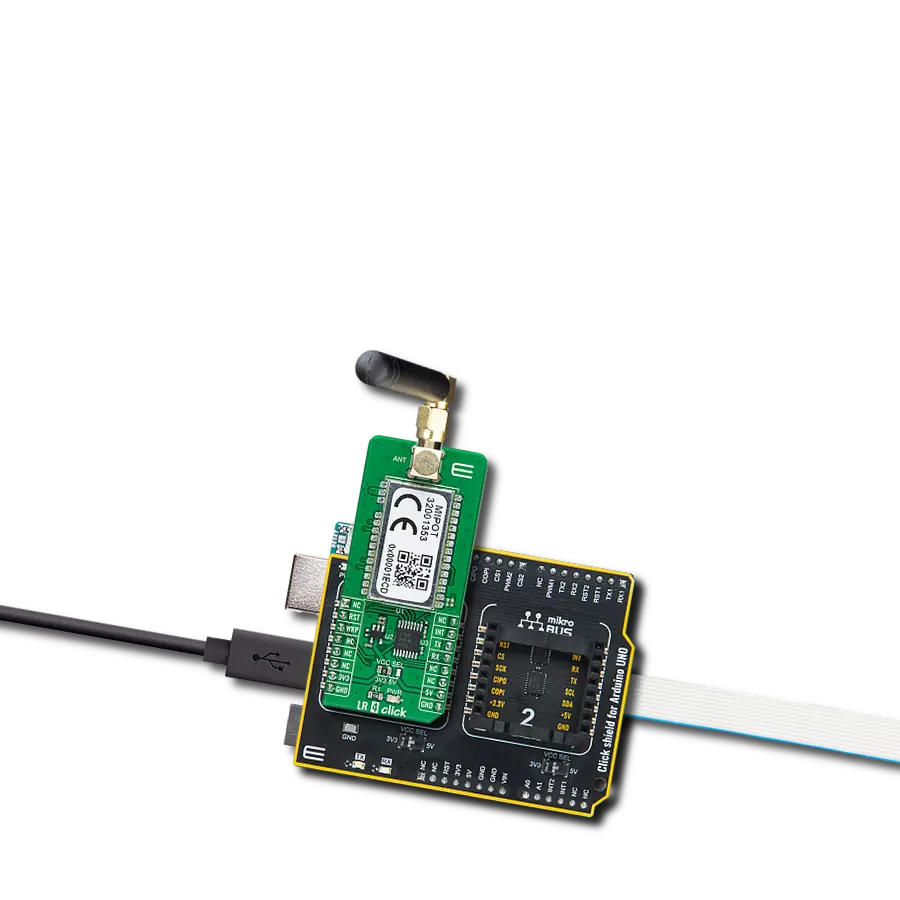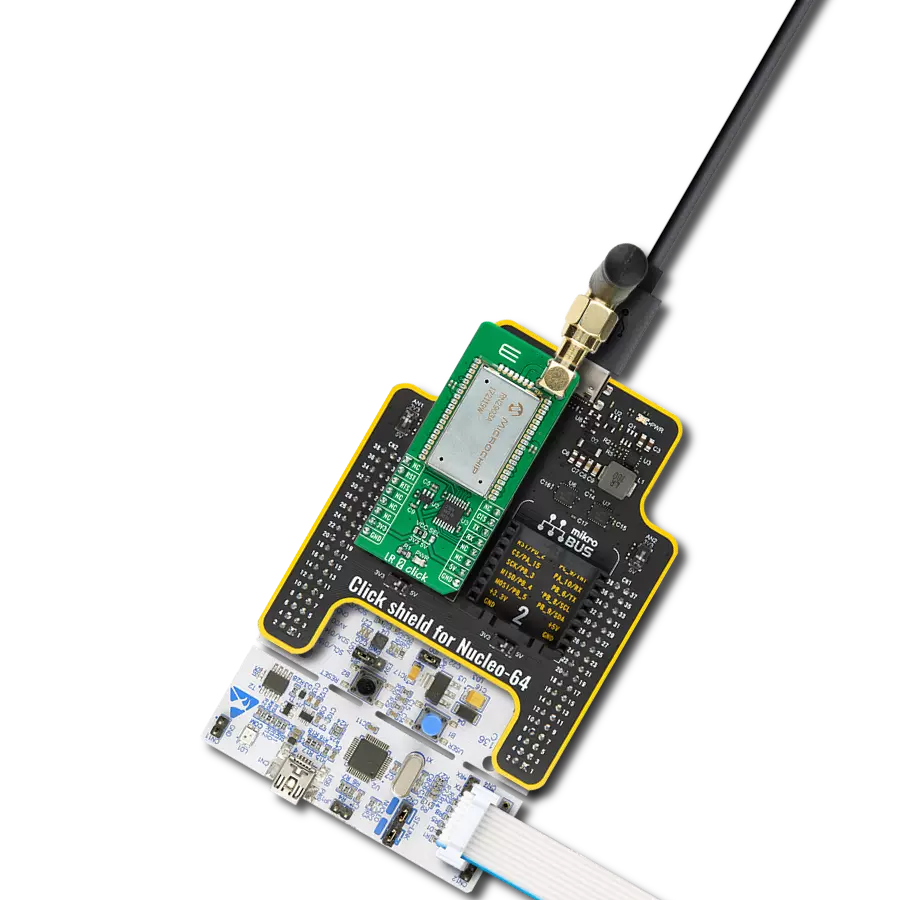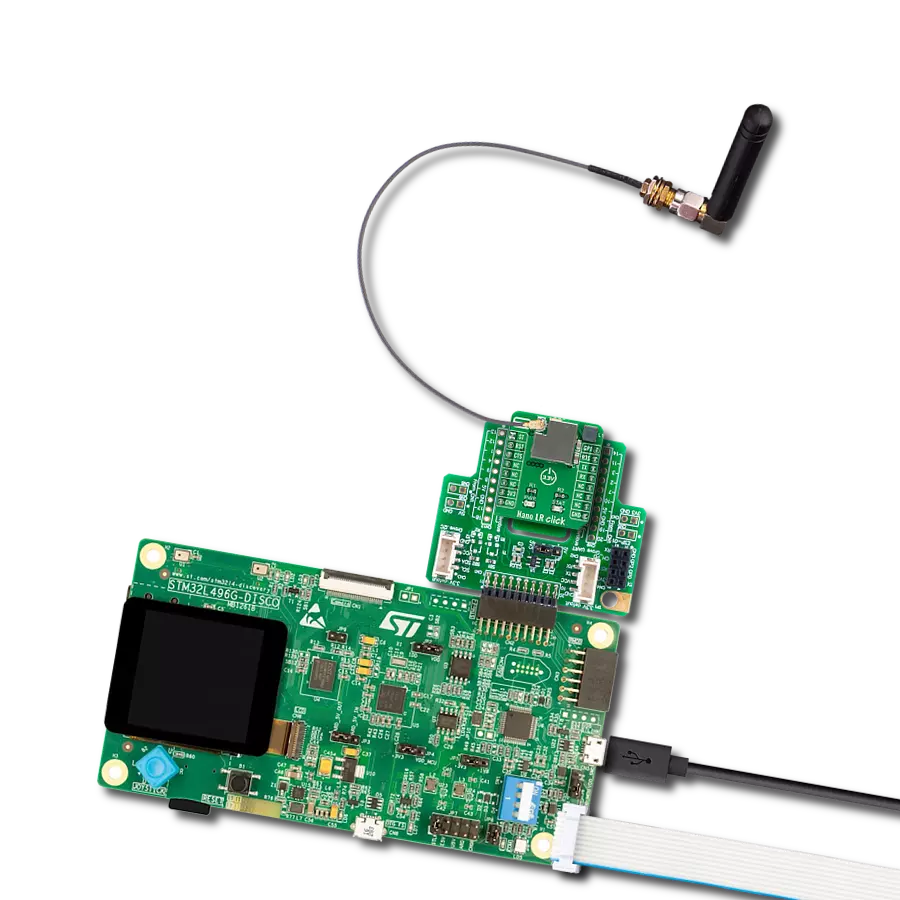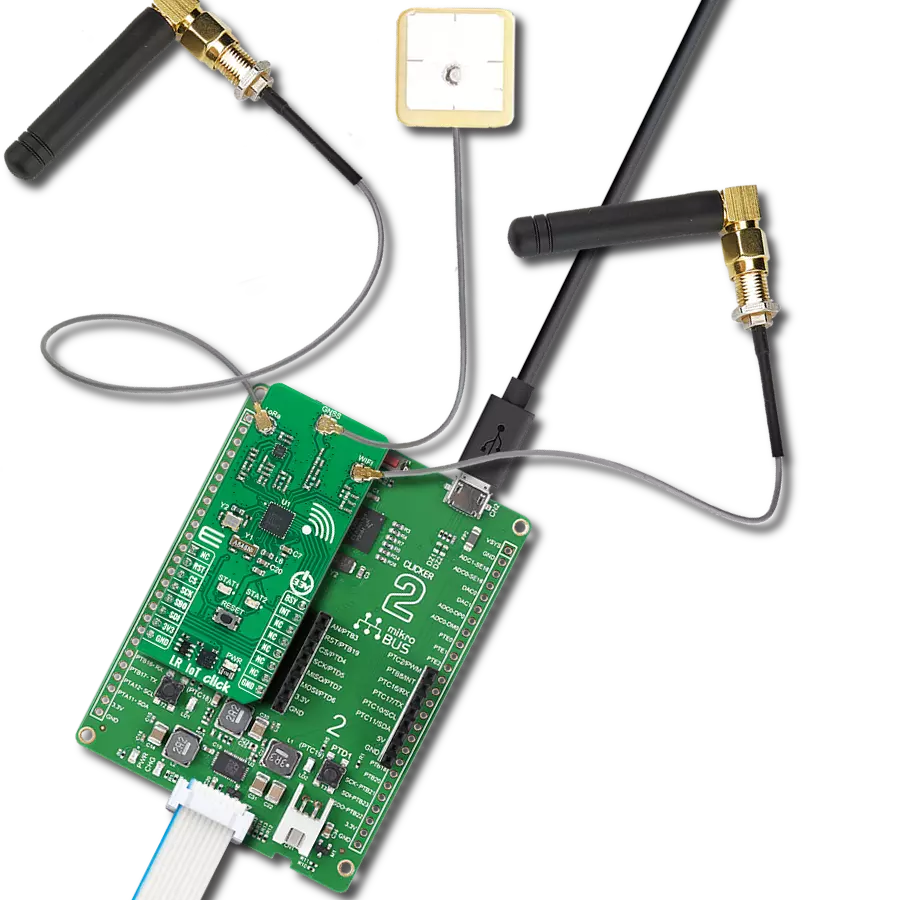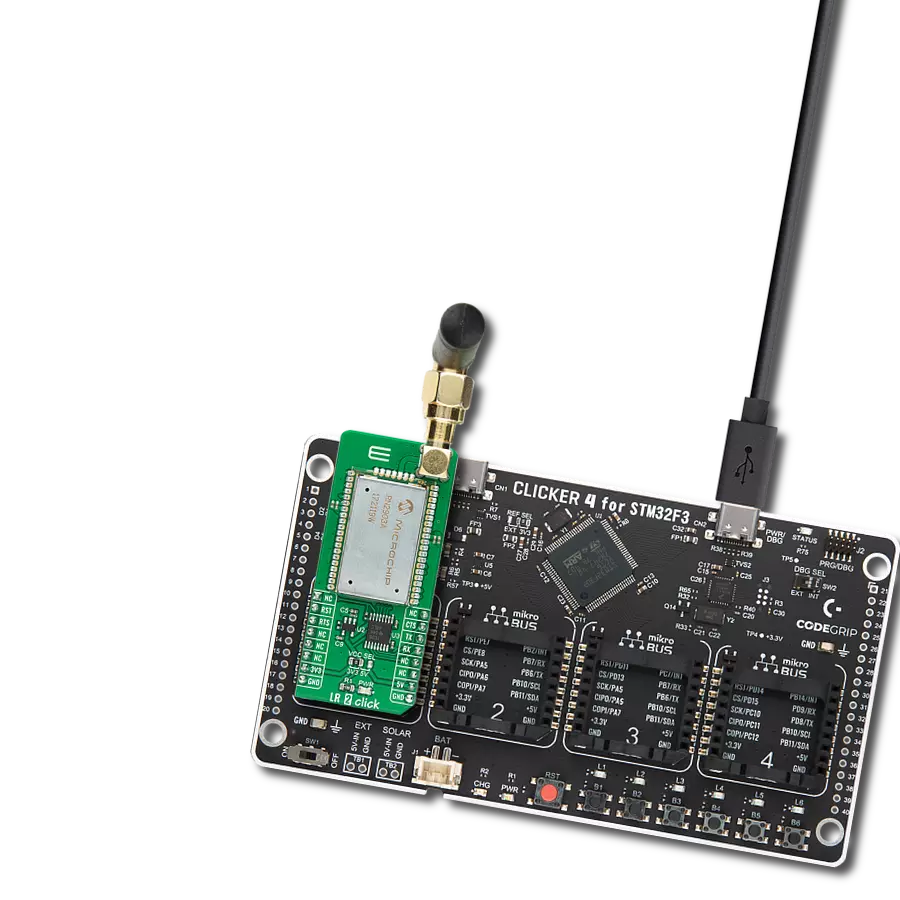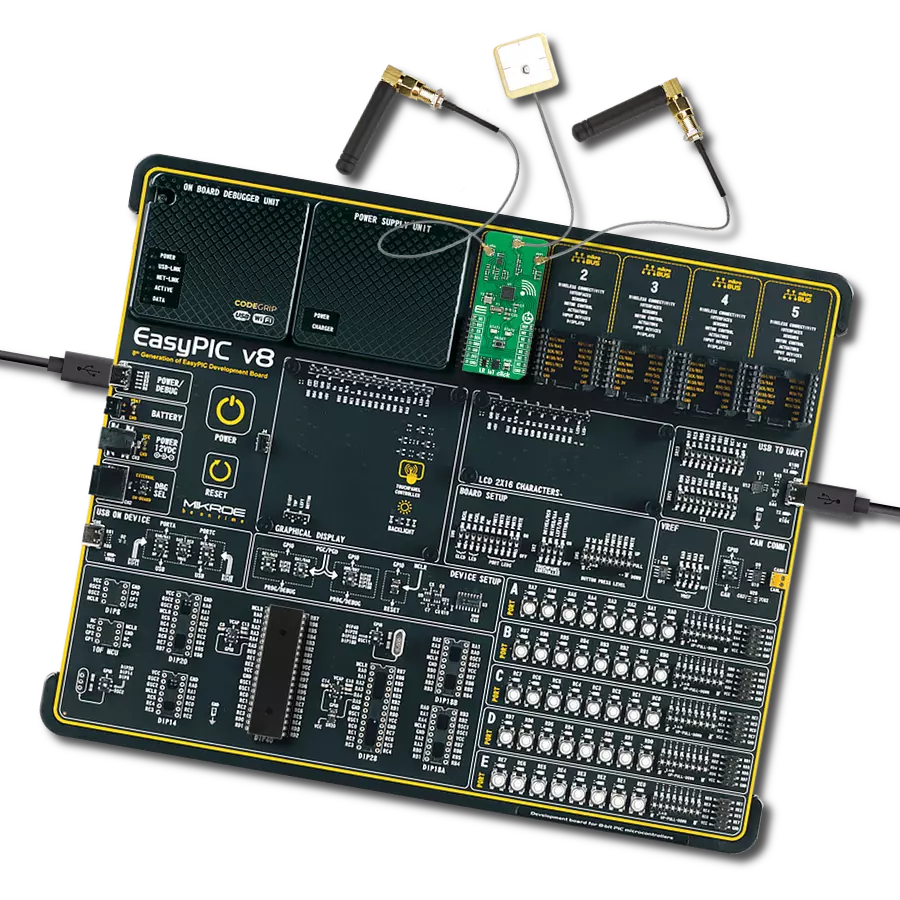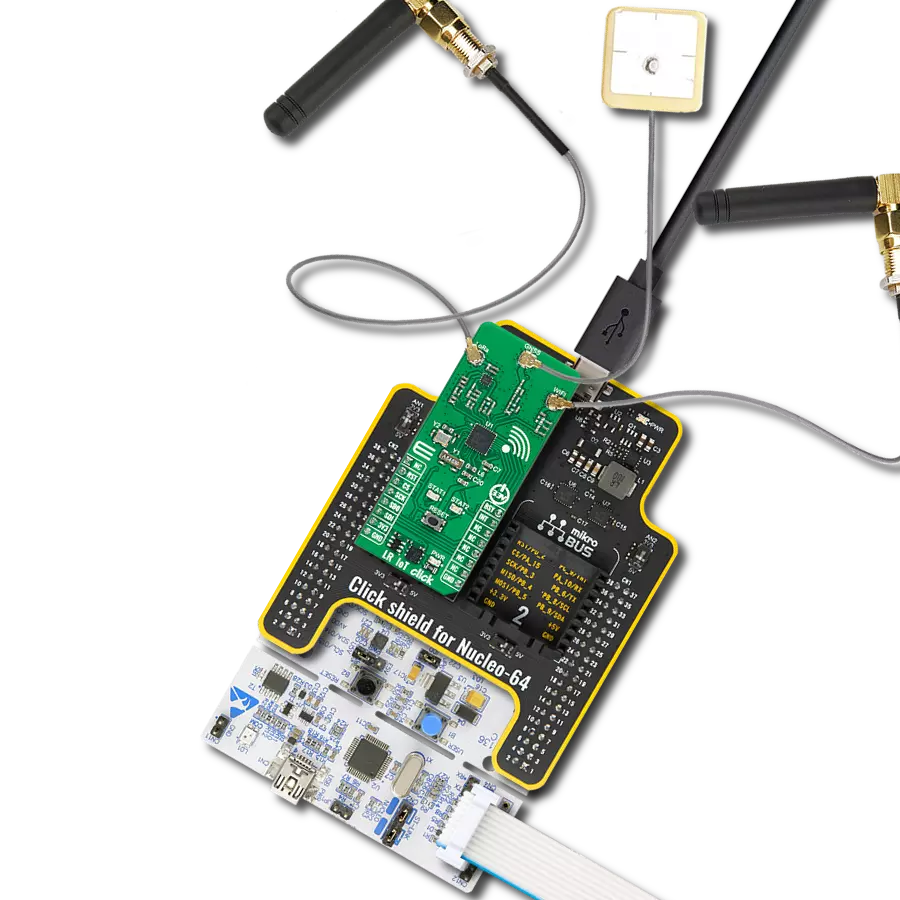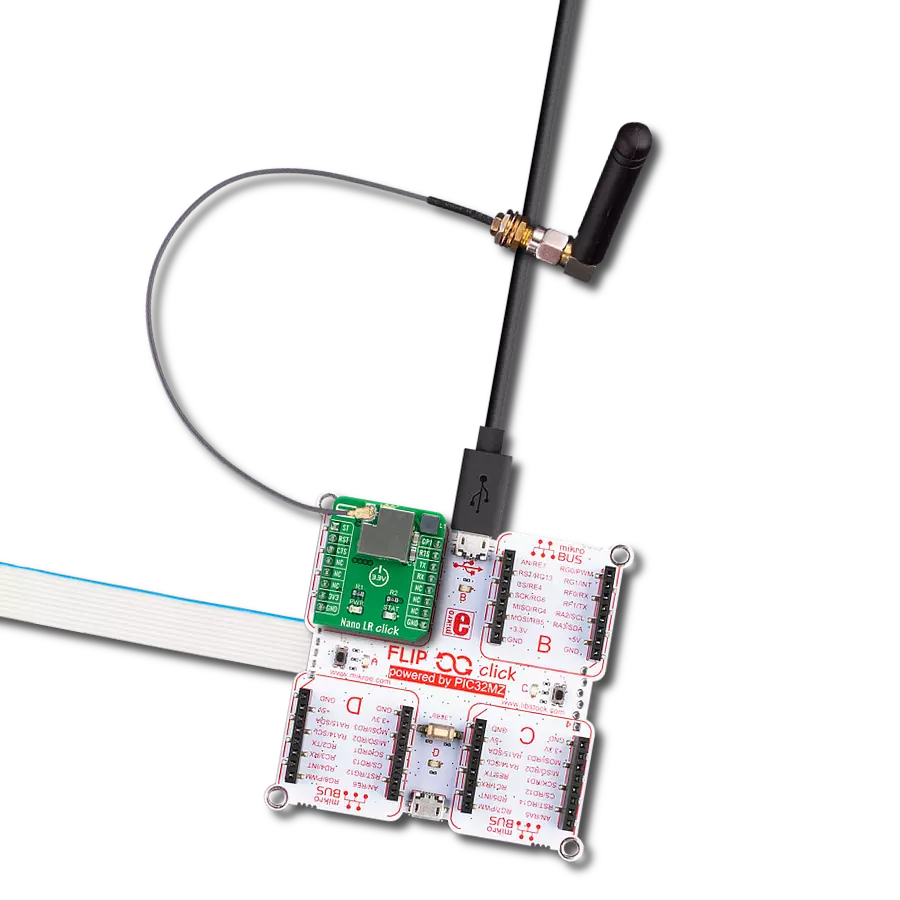LR物联网代表了连接的未来,一场开启物联网通信新可能的长距离革命。
A
A
硬件概览
它是如何工作的?
LR IoT Click基于Semtech Corporation的LR1110,这是一款旨在增强基于LoRa®的地理定位应用的长距离、超低功耗收发器。该平台解决方案支持LoRa®和(G)FSK调制,用于通过主动的868/915MHz ISM频段天线进行LPWAN应用,Mikroe也提供这种天线。LR1110还具有低功耗的多频段前端,可以获取多个用于地理定位的机会信号(802.11b/g/n WiFi AP MAC地址、GNSS(GPS、北斗)卫星信号),然后使用LPWAN网络将它们传输到地理定位服务器,该服务器计算物体的位置。此Click板™经过优化,适用于需要室内和室外地理定位的低功耗应用,例如资产定位、可追溯性、遗失和盗窃预防、资产回收和库存管理。LR1110使用三种操作模式:WiFi被动扫描和两种用于户外地理定位的GNSS模式,例如GNSS自主和辅助模式。通过WiFi被动扫描,LR1110可以发现设备附近可用的WiFi
b/g/n接入点并提取MAC地址以进行地理定位。目标是至少获取2个MAC地址,并在发送到在线WiFi查找服务后定位设备。LR1110实现的WiFi被动扫描还可以提取接入点在信标或探测响应中包含的国家代码信息。除了WiFi,还有一个快速且低功耗的GNSS扫描器,使用我们提供的主动GNSS天线,捕捉GNSS卫星广播的信号的一小部分并提取计算设备位置所需的信息。这些信息然后被汇集成NAV消息,可以发送到后端系统以计算设备位置。如前所述,GNSS扫描器有两种操作模式:自主和辅助。在自主模式下,不需要任何辅助数据,LR1110会搜索和解码强卫星的信号以进行室内/室外检测,而在辅助模式下,可以搜索所有可见卫星,并且需要与地理定位服务器连接以计算设备位置。此Click板™通过标准SPI接口与MCU通信,支持最常见的SPI模式——SPI模式0,最大频率为16MHz。它还具有
一个中断引脚,连接到mikroBUS™插槽的INT引脚,使主机MCU可以对LR1110系统中的特殊事件作出反应而无需寄存器轮询。一个“BUSY”指示器,标记为BSY,并连接到mikroBUS™插槽的PWM引脚,表示内部MCU无法接收来自主机MCU的任何命令,还有一个连接在mikroBUS™插槽RST引脚和板载复位按钮上的通用复位功能。它还使用两个LED指示器,标记为STAT1和STAT2,用于可选的GNSS和WiFi网络活动状态的视觉指示,当然也可以根据用户自己的愿望和需求进行配置。此Click板™仅可在3.3V逻辑电压水平下运行。使用具有不同逻辑电平的MCU之前,板必须进行适当的逻辑电压电平转换。此外,它配备了包含函数和示例代码的库,可用作进一步开发的参考。
功能概述
开发板
PIC32MZ Clicker 是一款紧凑型入门开发板,它将 Click 板™的灵活性带给您喜爱的微控制器,使其成为实现您想法的完美入门套件。它配备了一款板载 32 位带有浮点单元的 Microchip PIC32MZ 微控制器,一个 USB 连接器,LED 指示灯,按钮,一个 mikroProg 连接器,以及一个用于与外部电子设备接口的头部。得益于其紧凑的设计和清晰易识别的丝网标记,它提供了流畅且沉浸式的工作体验,允许在任
何情况下、任何地方都能访问。PIC32MZ Clicker 开 发套件的每个部分都包含了使同一板块运行最高效的必要组件。除了可以选择 PIC32MZ Clicker 的编程方式,使用 USB HID mikroBootloader 或通过外部 mikroProg 连接器为 PIC,dsPIC 或 PIC32 编程外,Clicker 板还包括一个干净且调节过的开发套件电源供应模块。USB Micro-B 连接可以提供多达 500mA 的电流,这足以操作所有板载和附加模块。所有
mikroBUS™ 本身支持的通信方法都在这块板上,包 括已经建立良好的 mikroBUS™ 插槽、重置按钮以及若干按钮和 LED 指示灯。PIC32MZ Clicker 是 Mikroe 生态系统的一个组成部分,允许您在几分钟内创建新的应用程序。它由 Mikroe 软件工具原生支持,得益于大量不同的 Click 板™(超过一千块板),其数量每天都在增长,它涵盖了原型制作的许多方面。
微控制器概述
MCU卡片 / MCU
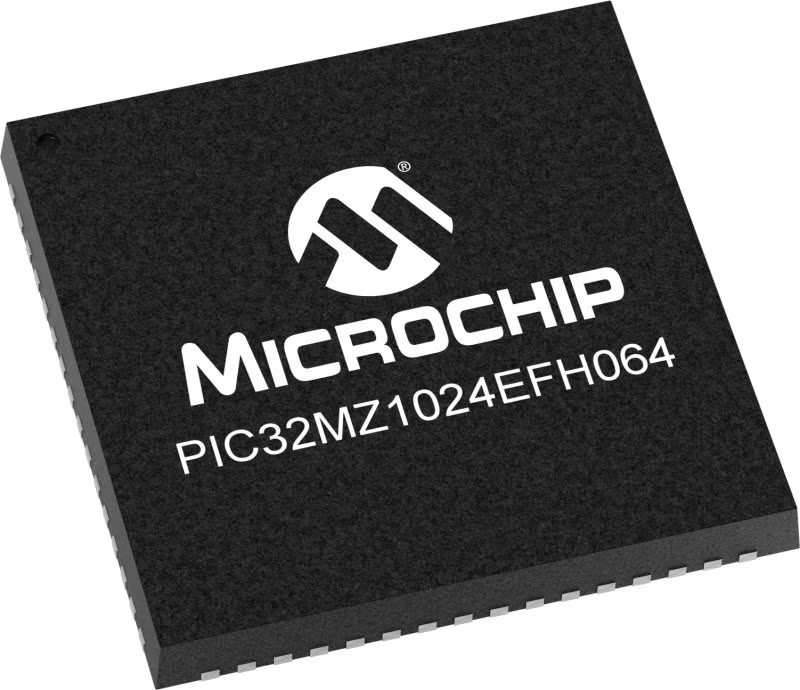
建筑
PIC32
MCU 内存 (KB)
1024
硅供应商
Microchip
引脚数
64
RAM (字节)
524288
你完善了我!
配件
868MHz直角橡胶天线是一种紧凑而多功能的无线通信解决方案。其工作频率范围为868-915MHz,确保最佳的信号接收和传输。具有50欧姆阻抗,兼容各种设备和系统。这款天线具有2dB增益,增强信号强度并延长通信范围。其垂直极化进一步提高了信号清晰度。设计能够处理高达50W的输入功率,是各种应用的坚固选择。天线长度仅为48毫米,既隐蔽又实用。SMA公头连接器确保与设备的连接安全可靠。无论是与物联网设备、远程传感器或其他无线技术配合使用,868MHz直角天线都能提供您所需的性能和灵活性,实现无缝通信。
这款GPS有源嵌入式天线是我们提供的所有GPS/GNSS Click板™的绝佳选择。凭借其高增益和有源频段过滤功能,当需要增强定位时,它是完美的选择。它可以直接安装在PCB上。GPS/GNSS模块配有一根10厘米长的小电缆,允许其远离小型IPEX连接器进行定位。
WiFi橡胶2.4GHz天线是一款为搭载WiFi模块的Click板™应用设计的多功能配件。这款天线专为增强无线连接而量身定制,是开发人员和工程师的必备之选。天线顶端采用直角SMA公头连接器,能够与Click板™或SMA母模块连接器无缝集成。这种用户友好型设计简化了安装,并确保在各种设置中的灵活性。工作在2400-2500MHz频率范围内,这款天线保证在广泛的WiFi网络中提供可靠连接。其50欧姆阻抗促进了高效的信号传输,而2dB增益显著增强了信号强度和范围。100MHz带宽轻松满足数据传输和通信稳定性需求。垂直极化进一步提高了信号接收能力。天线可以处理最高50W的输入功率,使其适用于高功率应用而不影响性能。其紧凑的50毫米长度确保其隐蔽且不引人注目。无论您是在设计物联网设备、智能家居应用还是工业设备,这款配备SMA公头连接器的WiFi橡胶天线都是确保最佳无线连接的理想选择。它是一款强大的工具,可使您的设备在无线技术中保持可靠连接和有效通信。
使用的MCU引脚
mikroBUS™映射器
“仔细看看!”
Click board™ 原理图

一步一步来
项目组装
软件支持
库描述
该库包含 LR IoT Click 驱动程序的 API。
关键功能:
lriot_get_wifi_scan_results- 此函数执行WiFi扫描并读取结果lriot_get_gnss_scan_results- 此函数执行GNSS扫描并读取结果lriot_send_lora_message- 此函数向接收器发送LoRa消息
开源
代码示例
完整的应用程序代码和一个现成的项目可以通过NECTO Studio包管理器直接安装到NECTO Studio。 应用程序代码也可以在MIKROE的GitHub账户中找到。
/*!
* @file main.c
* @brief LR IoT Click example
*
* # Description
* This example demonstrates the use of LR IoT Click board by reading a GNSS and WiFi
* scanning results and displaying it on the USB UART. In the case of a tranceive firmware
* the communication between two devices over LoRa will be demonstrated as well.
*
* The demo application is composed of two sections :
*
* ## Application Init
* Initializes the driver, performs the Click default configuration, and after that reads
* and displays the chip's firmware information. In the case you need to update or change the default
* firmware refer to the @b LRIOT_UPDATE_FIRMWARE and @b LRIOT_FIRMWARE_SELECTOR macro definition.
*
* ## Application Task
* There are 3 types of the example:
* 1. Modem firmware: reads a GNSS and WiFi scanning results and displays them on the USB UART.
* 2. Transcever firmware (application mode transmitter ): reads a GNSS and WiFi scanning results
* as well as the chip internal temperature and sends specific LoRa messages containing that information
* to the LoRa receiver.
* 3. Transcever firmware (application mode receiver): reads all incoming LoRa packets and displays them
* on the USB UART.
*
* @author Stefan Filipovic
*
*/
#include "board.h"
#include "log.h"
#include "lriot.h"
#include "conversions.h"
static lriot_t lriot;
static log_t logger;
#if ( LRIOT_FIRMWARE_SELECTOR == LRIOT_TRANSCEIVE_FIRMWARE )
// Comment out the line below in order to switch the application mode to receiver
#define DEMO_APP_TRANSMITTER
#endif
/**
* @brief LR IoT display gnss scan results function.
* @details This function parses a GNSS scan results object and displays it on the USB UART.
* @param[in] results : GNSS scan results object.
* See #lriot_gnss_scan_results_t object definition for detailed explanation.
* @return None.
* @note None.
*/
static void lriot_display_gnss_scan_results ( lriot_gnss_scan_results_t results );
/**
* @brief LR IoT display wifi scan results function.
* @details This function parses a WiFi scan results object and displays it on the USB UART.
* @param[in] results : WiFi scan results object.
* See #lriot_wifi_scan_results_t object definition for detailed explanation.
* @return None.
* @note None.
*/
static void lriot_display_wifi_scan_results ( lriot_wifi_scan_results_t results );
/**
* @brief LR IoT display chip info function.
* @details This function parses a chip firmware information object and displays it on the USB UART.
* @param[in] info : Chip information object.
* See #lriot_chip_info_t object definition for detailed explanation.
* @return None.
* @note None.
*/
static void lriot_display_chip_info ( lriot_chip_info_t info );
void application_init ( void )
{
log_cfg_t log_cfg; /**< Logger config object. */
lriot_cfg_t lriot_cfg; /**< Click config object. */
/**
* Logger initialization.
* Default baud rate: 115200
* Default log level: LOG_LEVEL_DEBUG
* @note If USB_UART_RX and USB_UART_TX
* are defined as HAL_PIN_NC, you will
* need to define them manually for log to work.
* See @b LOG_MAP_USB_UART macro definition for detailed explanation.
*/
LOG_MAP_USB_UART( log_cfg );
log_init( &logger, &log_cfg );
log_info( &logger, " Application Init " );
// Click initialization.
lriot_cfg_setup( &lriot_cfg );
LRIOT_MAP_MIKROBUS( lriot_cfg, MIKROBUS_1 );
if ( SPI_MASTER_ERROR == lriot_init( &lriot, &lriot_cfg ) )
{
log_error( &logger, " Communication init." );
for ( ; ; );
}
if ( LRIOT_ERROR == lriot_default_cfg ( &lriot ) )
{
log_error( &logger, " Default configuration." );
for ( ; ; );
}
lriot_chip_info_t chip_info;
if ( LRIOT_OK == lriot_get_chip_info ( &lriot, &chip_info ) )
{
lriot_display_chip_info ( chip_info );
}
log_info( &logger, " Application Task " );
}
void application_task ( void )
{
#if ( LRIOT_FIRMWARE_SELECTOR == LRIOT_TRANSCEIVE_FIRMWARE )
uint8_t lora_buffer[ LRIOT_LORA_PKT_PAYLOAD_LEN ] = { 0 };
#ifdef DEMO_APP_TRANSMITTER
lriot_gnss_scan_results_t gnss_results = { 0 };
lriot_wifi_scan_results_t wifi_results = { 0 };
uint8_t tmp_buf[ 30 ] = { 0 };
float temperature = 0;
if ( LRIOT_OK == lriot_get_gnss_scan_results ( &lriot, &gnss_results ) )
{
lriot_display_gnss_scan_results ( gnss_results );
}
memset( lora_buffer, 0, sizeof ( lora_buffer ) );
strcpy( lora_buffer, "Number of sattelites found is " );
uint16_to_str ( gnss_results.num_satellites, tmp_buf );
l_trim ( tmp_buf );
strcat( lora_buffer, tmp_buf );
if ( LRIOT_OK == lriot_send_lora_message ( &lriot, lora_buffer ) )
{
log_printf( &logger, "Send LoRa message - done\r\n" );
}
if ( LRIOT_OK == lriot_get_wifi_scan_results ( &lriot, &wifi_results ) )
{
lriot_display_wifi_scan_results ( wifi_results );
}
memset( lora_buffer, 0, sizeof ( lora_buffer ) );
strcpy( lora_buffer, "Number of WiFi scan results is " );
uint16_to_str ( wifi_results.num_wifi_results, tmp_buf );
l_trim ( tmp_buf );
strcat( lora_buffer, tmp_buf );
if ( LRIOT_OK == lriot_send_lora_message ( &lriot, lora_buffer ) )
{
log_printf( &logger, "Send LoRa message - done\r\n" );
}
log_printf ( &logger, "**************************************************************\r\n" );
if ( LRIOT_OK == lriot_get_temperature ( &lriot, &temperature ) )
{
log_printf ( &logger, "Temperature : %.2f degC\r\n", temperature );
}
memset( lora_buffer, 0, sizeof ( lora_buffer ) );
strcpy( lora_buffer, "My temperature is " );
float_to_str ( temperature, tmp_buf );
l_trim ( tmp_buf );
tmp_buf[ 5 ] = 0;
strcat( lora_buffer, tmp_buf );
strcat( lora_buffer, " degC" );
if ( LRIOT_OK == lriot_send_lora_message ( &lriot, lora_buffer ) )
{
log_printf( &logger, "Send LoRa message - done\r\n" );
}
#else
lriot_lora_packet_status_t pkt_status;
if ( LRIOT_OK == lriot_read_lora_message ( &lriot, &pkt_status, lora_buffer ) )
{
log_printf ( &logger, "**************************************************************\r\n" );
log_printf ( &logger, "* RECEIVED LORA PACKET *\r\n" );
log_printf ( &logger, "**************************************************************\r\n" );
log_printf ( &logger, " RSSI : %d dBm\r\n", ( uint16_t ) pkt_status.rssi_pkt_in_dbm );
log_printf ( &logger, " Signal RSSI : %d dBm\r\n", ( uint16_t ) pkt_status.signal_rssi_pkt_in_dbm );
log_printf ( &logger, " SNR : %d dB\r\n", ( uint16_t ) pkt_status.snr_pkt_in_db );
log_printf ( &logger, " Message : \"%s\"\r\n\n", lora_buffer );
}
#endif
#else
lriot_gnss_scan_results_t gnss_results = { 0 };
lriot_wifi_scan_results_t wifi_results = { 0 };
if ( LRIOT_OK == lriot_get_gnss_scan_results ( &lriot, &gnss_results ) )
{
lriot_display_gnss_scan_results ( gnss_results );
}
if ( LRIOT_OK == lriot_get_wifi_scan_results ( &lriot, &wifi_results ) )
{
lriot_display_wifi_scan_results ( wifi_results );
}
#endif
}
int main ( void )
{
/* Do not remove this line or clock might not be set correctly. */
#ifdef PREINIT_SUPPORTED
preinit();
#endif
application_init( );
for ( ; ; )
{
application_task( );
}
return 0;
}
static void lriot_display_gnss_scan_results ( lriot_gnss_scan_results_t results )
{
log_printf ( &logger, "**************************************************************\r\n" );
log_printf ( &logger, "* GNSS SCAN RESULTS *\r\n" );
log_printf ( &logger, "**************************************************************\r\n" );
log_printf ( &logger, "Number of satellites found: %u\r\n", ( uint16_t ) results.num_satellites );
#if ( LRIOT_FIRMWARE_SELECTOR == LRIOT_TRANSCEIVE_FIRMWARE )
for ( uint8_t cnt = 0; cnt < results.num_satellites; cnt++ )
{
log_printf ( &logger, "{\r\n\tSatellite ID : %u", results.satellite_id_cnr_doppler[ cnt ].satellite_id );
log_printf ( &logger, "\r\n\tC/N0 : %d dB-Hz", results.satellite_id_cnr_doppler[ cnt ].cnr );
log_printf ( &logger, "\r\n\tSV doppler : %d Hz\r\n},\r\n", results.satellite_id_cnr_doppler[ cnt ].doppler );
}
#else
for ( uint8_t cnt = 0; cnt < results.num_satellites; cnt++ )
{
log_printf ( &logger, "{\r\n\tSatellite ID : %u", results.satellite_id_cnr[ cnt ].satellite_id );
log_printf ( &logger, "\r\n\tC/N0 : %d dB-Hz\r\n},\r\n", results.satellite_id_cnr[ cnt ].cnr );
}
#endif
if ( ( results.scan_results_len > 0 ) &&
( LR1110_GNSS_DESTINATION_SOLVER == results.destination_id ) )
{
log_printf ( &logger, "NAV message : " );
for ( uint16_t cnt = 0; cnt < results.scan_results_len; cnt++ )
{
log_printf ( &logger, "%.2X", results.scan_results[ cnt ] );
}
log_printf ( &logger, "\r\n" );
}
}
static void lriot_display_wifi_scan_results ( lriot_wifi_scan_results_t results )
{
log_printf ( &logger, "**************************************************************\r\n" );
log_printf ( &logger, "* WiFi SCAN RESULTS *\r\n" );
log_printf ( &logger, "**************************************************************\r\n" );
log_printf ( &logger, "Number of WiFi results: %u\r\n", ( uint16_t ) results.num_wifi_results );
for ( uint8_t i = 0; i < results.num_wifi_results; i++ )
{
log_printf ( &logger, "{\r\n\tSSID : \"%s\",\r\n\tMAC : \"", results.scan_results[ i ].ssid_bytes );
for ( uint16_t j = 0; j < LR1110_WIFI_MAC_ADDRESS_LENGTH; j++ )
{
log_printf ( &logger, "%.2x", ( uint16_t ) results.scan_results[ i ].mac_address_2[ j ] );
if ( j < ( LR1110_WIFI_MAC_ADDRESS_LENGTH - 1 ) )
{
log_printf ( &logger, ":" );
}
}
log_printf ( &logger, "\",\r\n\tChannel: %u,\r\n", ( int16_t ) results.scan_results[ i ].current_channel );
log_printf ( &logger, "\tType : %u,\r\n", ( int16_t ) results.scan_results[ i ].data_rate_info_byte );
log_printf ( &logger, "\tRSSI : %d dBm\r\n},\r\n", ( int16_t ) results.scan_results[ i ].rssi );
}
log_printf ( &logger, "Scanning time : %d ms\r\n",
( results.timings.demodulation_us + results.timings.rx_capture_us +
results.timings.rx_correlation_us + results.timings.rx_detection_us ) / 1000 );
}
static void lriot_display_chip_info ( lriot_chip_info_t info )
{
log_printf ( &logger, "**************************************************************\r\n");
log_printf ( &logger, "* CHIP INFO *\r\n");
log_printf ( &logger, "**************************************************************\r\n");
#if ( LRIOT_FIRMWARE_SELECTOR == LRIOT_TRANSCEIVE_FIRMWARE )
log_printf ( &logger, "HARDWARE : 0x%.2X\r\n", ( uint16_t ) info.version.hw );
log_printf ( &logger, "TYPE : 0x%.2X\r\n", ( uint16_t ) info.version.type );
log_printf ( &logger, "FIRMWARE : 0x%.4X\r\n", info.version.fw );
log_printf ( &logger, "UID : " );
for ( uint8_t cnt = 0; cnt < ( LR1110_SYSTEM_UID_LENGTH - 1 ); cnt++ )
{
log_printf ( &logger, "%.2X-", ( uint16_t ) info.uid[ cnt ] );
}
log_printf ( &logger, "%.2X\r\n", ( uint16_t ) info.uid[ LR1110_SYSTEM_UID_LENGTH - 1 ] );
log_printf ( &logger, "JOIN EUI : " );
for ( uint8_t cnt = 0; cnt < ( LR1110_SYSTEM_JOIN_EUI_LENGTH - 1 ); cnt++ )
{
log_printf ( &logger, "%.2X-", ( uint16_t ) info.join_eui[ cnt ] );
}
log_printf ( &logger, "%.2X\r\n", ( uint16_t ) info.join_eui[ LR1110_SYSTEM_JOIN_EUI_LENGTH - 1 ] );
log_printf ( &logger, "PIN : " );
for ( uint8_t cnt = 0; cnt < LR1110_SYSTEM_PIN_LENGTH; cnt++ )
{
log_printf ( &logger, "%.2X", ( uint16_t ) info.pin[ cnt ] );
}
log_printf ( &logger, "\r\n\n" );
#else
log_printf ( &logger, "BOOTLOADER : 0x%.8LX\r\n", info.version.bootloader );
log_printf ( &logger, "FIRMWARE : 0x%.8LX\r\n", info.version.firmware );
log_printf ( &logger, "LORAWAN : 0x%.4X\r\n", info.version.lorawan );
log_printf ( &logger, "CHIP EUI : " );
for ( uint8_t cnt = 0; cnt < ( LR1110_MODEM_CHIP_EUI_LENGTH - 1 ); cnt++ )
{
log_printf ( &logger, "%.2X-", ( uint16_t ) info.chip_eui[ cnt ] );
}
log_printf ( &logger, "%.2X\r\n", ( uint16_t ) info.chip_eui[ LR1110_MODEM_CHIP_EUI_LENGTH - 1 ] );
log_printf ( &logger, "DEV EUI : " );
for ( uint8_t cnt = 0; cnt < ( LR1110_MODEM_DEV_EUI_LENGTH - 1 ); cnt++ )
{
log_printf ( &logger, "%.2X-", ( uint16_t ) info.dev_eui[ cnt ] );
}
log_printf ( &logger, "%.2X\r\n", ( uint16_t ) info.dev_eui[ LR1110_MODEM_DEV_EUI_LENGTH - 1 ] );
log_printf ( &logger, "JOIN EUI : " );
for ( uint8_t cnt = 0; cnt < ( LR1110_MODEM_JOIN_EUI_LENGTH - 1 ); cnt++ )
{
log_printf ( &logger, "%.2X-", ( uint16_t ) info.join_eui[ cnt ] );
}
log_printf ( &logger, "%.2X\r\n", ( uint16_t ) info.join_eui[ LR1110_MODEM_JOIN_EUI_LENGTH - 1 ] );
log_printf ( &logger, "PIN : %.8LX\r\n\n", info.pin );
#endif
}
// ------------------------------------------------------------------------ END
